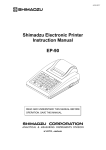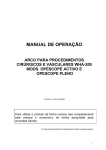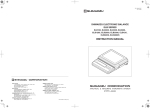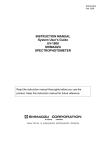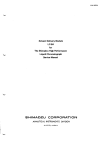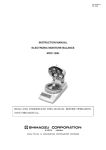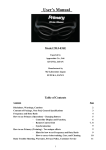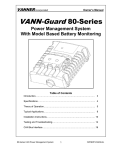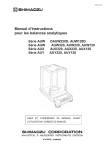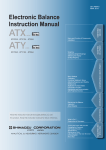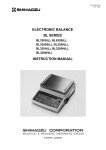Download Shimadzu EP-90 Instruction manual
Transcript
321-62706-21B Nov. 2008 Shimadzu Electronic Printer Instruction Manual EP-80 Read the instruction manual thoroughly before you use the product. Keep this instruction manual for future reference. Declaration Of Conformity Shimadzu Corporation declares that the following product: EP-80 Electronic Printer conforms to the following directives. Directives EMC directive 89/336/EEC amended by 92/31/EEC, 93/68/EEC EN55022: 1994 / A1: 1995 / A2: 1997 (Class B) EN55024: 1998 EN61000-3-2: 1995 /A1: 1998 /A2: 1998, EN61000-3-3: 1995 Low Voltage directive 73/23/EEC amended by 93/68/EEC EN60950: 1992 /A1: 1993 /A2: 1993 Weighing Instruments Department Analytical & Measuring Instruments Division SHIMADZU CORPORATION 1, Nishinokyo-Kuwabaracho Nakagyo-ku, Kyoto-shi 604-8511 JAPAN -I- Contents Declaration Of Conformity 1. Introduction ........................................................................................... 1 2. Packing List and Component Names ............................................................ 5 2.1 Packing list ...............................................................................................................5 2.2 Main unit components ..............................................................................................5 3. Installation ............................................................................................. 6 3.1 Installation Site.........................................................................................................6 3.2 Power .......................................................................................................................6 3.3 Installation ................................................................................................................8 3.3.1 Connecting to power (when using AC adapter) ..............................................8 3.3.2 Loading batteries (when using batteries) ........................................................8 3.3.3 Loading printer paper......................................................................................9 3.4 Connecting the Balance ......................................................................................... 11 4. Functions and Operation ................................................................... 12 4.1 Key Switches .........................................................................................................12 4.2 Output from the Balance ........................................................................................12 4.3 Statistic Calculation Mode ......................................................................................12 4.4 Auto Print Mode .....................................................................................................14 5. Communication and Other Settings .......................................................... 15 5.1 DIP Switches..........................................................................................................15 5.2 Settings ..................................................................................................................16 5.2.1 Communication Setting 1 (Baud rate)...........................................................16 5.2.2 Communication Setting 2 (Parity) .................................................................16 5.2.3 Communication Setting 3 (Delimiter) ............................................................16 5.2.4 English / Japanese .......................................................................................17 5.2.5 Buzzer ON/OFF ............................................................................................17 6. Maintenance ........................................................................................ 18 6.1 Refilling Printer Paper ............................................................................................18 6.2 Replacing Ink Ribbon Cartridge .............................................................................18 6.3 Replacing Batteries ................................................................................................18 7. Troubleshooting .................................................................................. 19 -i- Contents 8. Parts List ..............................................................................................20 9. Specifications ......................................................................................21 10. Dimensions ..........................................................................................22 - ii - 1. Introduction 1. Introduction Shimadzu Electronic Printer EP-80 is designed to be used with Shimadzu Electronic Balances. It is easy to operate and useful for a wide range of applications and measurement administration. Capability of battery operation is convenient for field use and transportation. Printing method is impact dot on normal paper, which is suitable for long term storage. Data output, auto print activation and taring commands can be sent to an attached balance by the printer keys. Statistic calculation function allows up to 1000 samples to be calculated and prints out the results. Read this instruction manual carefully and use the balance correctly in accordance with the directions in the manual. When you have finished reading the manual, keep it in a safe place together with the balance so that you can refer to it at any time. For information on the following points, please contact your Shimadzu Balance representative. • Product warranty • After service Requests • Provide this manual to the next user in the event that the instrument is transferred. • To ensure safe operation, contact your Shimadzu Balance representative for installation, adjustment, or reinstallation after moving the instrument to a different site. Notices • The content of this manual is subject, without notice, to modifications for the sake of improvement. • Every effort has been made to ensure that the content of this manual was correct at the time of creation. However, in the event that any mistakes or omissions are discovered, it may not be possible to correct them immediately. • The copyright of this manual is owned by Shimadzu Corporation. Reproduction and duplication of whole or part of the content without permission of the company are strictly prohibited. • “Microsoft”, “Windows”, “Windows Vista” and “Excel” are registered trademarks of Microsoft Corporation of the U.S.A. in the United States and other countries. All other company names 1 1. Introduction and product names that appear in this manual are trademarks or registered trademarks of the companies concerned. Note that ™ and ® indications are not used. • The company names, organization names and product names in this manual are trademarks or registered trademarks of the companies and organizations concerned. • Shimadzu does not guarantee that the WindowsDirect communication function will operate without problems on all PCs. Shimadzu will accept no responsibility for any trouble that arises as a result of using this function. You are recommended to back up all important data and programs in advance. © 2007-2008 Shimadzu Corporation. All rights reserved. Action for Environment (WEEE) To all user of Shimadzu equipment in the European Union: Equipment marked with this symbol indicates that it was sold on or after 13th August 2005, which means it should not be disposed of with general household waste. Note that our equipment is for industrial/professional use only. Contact Shimadzu service representative when the equipment has reached the end of its life. They will advise you regarding the equipment take-back. With your co-operation we are aiming to reduce contamination from waste electronic and electrical equipment and preserve natural resource through re-use and recycling. Do not hesitate to ask Shimadzu service representative, if you require further information. WEEE Mark 2 1. Introduction Safety Precautions To be strictly observed To ensure that you use the balance safely and correctly, read the following precautions carefully and observe them. The levels of danger and damage that will arise if the balance is used incorrectly are classified and indicated as shown below. WARNING Indicates a potentially hazardous situation which, if not avoided, could result in serious injury or possibly death. CAUTION Indicates a potentially hazardous situation which, if not avoided, may result in minor to moderate injury or equipment damage. Precautions are classified and explained by using one of the symbols below, depending on the nature of the precaution. Indicates an action that must be performed. Instructions Indicates an action that must NOT be performed. Prohibitions WARNING Never disassemble, modify or attempt to repair this product or any accessory. Prohibitions You could sustain an electric shock or the product could operate abnormally. If you believe that the balance has failed, contact your Shimadzu representative. Use the balance with the specified power supply and voltage. Instructions Using the printer with an incorrect power supply or voltage will lead to fire or trouble with the printer. Note also that if the power supply or voltage is unstable or if the power supply capacity is insufficient, it will not be possible to obtain satisfactory performance from the printer. Do not use the balance outdoors or anywhere where it will be exposed to water. Prohibitions You could sustain an electric shock or the product could operate abnormally. 3 1. Introduction CAUTION Avoid locations where the balance will be exposed to any of the following. Prohibitions This could cause accidents or poor performance. ● Extreme temperature changes ● Vibration ● Direct sunlight ● Corrosive or flammable gases ● Dust, electromagnetic waves or a magnetic field Install the balance on a strong and stable flat table or floor. Instructions Placing the printer in an unstable site could lead to injury or trouble with the balance. After a power outage, turn the power back ON. Instructions When a power outage occurs, the power is shut off automatically. Therefore, begin operation from “3.3 Installation”. Treat the balance with care and respect. Instructions The printer is a precision instrument. Subjecting it to impacts could cause it to fail. If the printer has to be stored for a long time, store it in the packaging box in which it was delivered. Do not connect anything other than balance specified by Shimadzu. Prohibitions In order to avoid trouble, always connect balance in accordance with the directions in this manual. If you detect anything abnormal (e.g. a burning smell) disconnect the AC adapter immediately. Instructions 4 Continuing to use the balance with an abnormality could lead to fire or an electric shock. 2. Packing List and Component Names 2. Packing List and Component Names 2.1 Packing list Unpack and verify that the following standard packed items (one each) are present. Connection Cable Printer Main Unit Printer Paper and Printer Paper Shaft Instruction manual AC Adapter The shape of the supplied AC adapter may differ from the figure above. 2.2 Main unit components (1) Power switch (2) Command keys (3) Printer paper cover (4) Power connector (5) Data I/O connector (6) Battery cover (7) LOW BATT lamp (8) Power indication lamp (9) Statistics lamp (10) Auto print lamp (11) Cutter 5 3. Installation 3. Installation 3.1 Installation Site Caution For safe and proper operation, avoid sites where EP-80 is exposed to the following: • Corrosive or flammable gasses • Dust, wind, electromagnetic waves, or magnetic fields • Direct sunlight • Extreme temperature, temperature changes or humidity 3.2 Power EP-80can be operated either with AC adapter or with batteries. (When using AC Adapter) Choose a site where the standard AC adapter can be used. Make certain the supplied power voltage meets the AC adapter's specification. Remove batteries when using AC adapter. (When using batteries) Use alkaline batteries only. Disconnect AC adapter when using batteries. Make certain to turn power switch after use. Replace with new batteries promptly when LOW BATT lamp is illuminated. 6 3. Installation Caution Observe the following instructions about handling batteries. 1. Load batteries observing the polarity. 2. Do not mix new and used batteries. 3. Do not mix batteries of different kinds. 4. Do not use any rechargeable batteries. 5. Remove and dispose of used batteries as soon as LOW BATT lamp is illuminated. 6. Remove batteries when printer is not in use for a long period. Caution Use the AC adapter supplied by Shimadzu representative only. (DC 9V-12V, 2A) Using other adapters may cause failure. When EP-80 is not in use, disconnect AC adapter from power source. 7 3. Installation 3.3 Installation 3.3.1 Connecting to power (when using AC adapter) Verify power switch is off. Connect AC adapter to EP-80. Connect AC adapter to designated power source. Switch OFF Power Source Power Cable Switch ON The shape of the supplied AC adapter may differ from the figure above. 3.3.2 Loading batteries (when using batteries) Disconnect AC adapter. Turn power switch OFF. Turn over the printer main unit and remove battery cover. Load batteries as shown in the figure. Load batteries correctly observing the polarity shown in the figure. Use alkaline batteries only. 8 3. Installation 3.3.3 Loading printer paper Connect AC adapter or load batteries. Remove printer paper cover. (How to remove printer paper cover) Lift rear of printer as shown in the figure. (When replacing, take out the remaining roll and pull out printer paper shaft.) Verify there are no bends or folds in the paper end. Insert printer paper shaft to the center of the paper roll as shown in the figure. (Printer paper shaft is inserted when EP-80 is delivered) Turn power switch ON. 9 3. Installation Keep pressing [FEED] key while inserting the printer paper end into the slot of the printer mechanism as shown in the figure. Feed the paper until its end comes out. Place printer paper shaft on the bearings and tension the paper. Bearing Close printer paper cover. (How to fit printer paper cover) Slide printer paper cover forward as shown in the figure, then lower the rear to close it. 10 3. Installation 3.4 Connecting the Balance Cable connection Turn OFF the balance and EP-80. Firmly attach connection cable to the I/O connectors of the balance and EP-80. Turning power ON/OFF Follow the sequence below when turning ON/OFF. (1) When turning ON Turn ON the balance first and then EP-80. (2) When turning OFF Turn OFF EP-80 first and then the balance. 11 4. Functions and Operation 4. Functions and Operation 4.1 Key Switches Key Functions [TARE] Tares the balance (Zeros the display) [PRINT] Receives the balance's displayed data and prints it out once [AUTO PRINT] Turn ON/OFF the auto print function of the balance First operation: Enters the statistic calculation mode [STAT.] Second operation (while statistics lamp is lit): Prints out the results of statistic calculation and exits the statistic calculation mode. Feeds the printer paper by one line. If kept held down, continuously feeds until [FEED] 4.2 released. Output from the Balance While weighed result is displayed on the balance, if [PRINT] key of EP-80 or [PRINT] key of the balance is pressed, the displayed value will be printed out with an indication of the weighing unit. Depending on the balance series, various data apart from weighed results such as calibration report, application measurement results, date and time can also be output to EP-80 for printing. The [PRINT] key of the balance or the balance's function menu should be used to output such items. Refer to the balance's operation manual for instructions. 4.3 Statistic Calculation Mode (1) Press [STAT.] key while statistics lamp is OFF. Statistics lamp will be illuminated and a message will be printed out to indicate the printer has entered the statistic calculation mode. (The first line of the print out example) (2) Place the sample on the balance. (3) Press [PRINT] key. The weighed result will be printed with numbering "NO. 0001". (the second line of the print out example) (4) Remove the sample from the balance. (5) Repeat (2) to (4) for the rest of samples. The samples are numbered continuously. (6) Press [STAT.] key when all the samples have been weighed. The results of statistic calculation will be printed out. Statistic calculation mode is then exited and statistics lamp goes OFF. 12 4. Functions and Operation The results of statistic calculation are printed out in the following order. Order in print out Statistics Symbol in print out 1 Number of samples N 2 Total T Description 3 Maximum MAX 4 Minimum MIN 5 Range RNG = MAX – MIN =T/N 6 Mean MEAN 7 Standard deviation SD ∑ (Xi − MEAN) 2 N −1 • Statistics of up to 1,000 samples can be calculated. When the number of samples reaches 1,000, statistic calculation will be automatically performed, the results will be printed out, and the statistic calculation mode will be exited. • Once the results of statistic calculation have been printed out and the statistic calculation mode has been exited, the data that has been obtained up to that point can no longer be recalled. The number of significant figures is 7 in EP-80. The calculated values may contain errors due to the smaller number of digits of data depending on the balance model. (Example of print out) 13 4. Functions and Operation 4.4 Auto Print Mode Auto print function prints out the weighed result automatically as a sample is placed on the balance pan and the display stabilizes. Productivity is enhanced as the operator doesn't have to press any key. (1) Press [AUTO PRINT] key. The auto print function of the balance is activated and auto print lamp of EP-80 will be illuminated. (2) Press [TARE] key of the balance or EP-80. The balance display will be zeroed. (3) Place the sample on the balance pan. The weighed result will be automatically printed out when the display stabilizes. (4) Press [AUTO PRINT] key while auto print lamp is illuminated to turn off the auto print function. Notes Conditions for data output in auto print mode vary depending on the balance series. Refer to the balance instruction manual for UW/UX series, BW/BX series, BW-K/BX-K series and AUW-D/AUW/AUX/AUY series. With UW/UX series, BW/BX series and BW-K/BX-K series, select one of the several auto print modes in the balance's function menu. When auto print function is turned ON with [PRINT] key of EP-80, the auto print mode which is currently set will be activated. Switching between auto print modes can be performed using the balance's menu. 14 5. Communication and Other Settings 5. Communication and Other Settings In EP-80 electronic printer, five settings including three communication settings can be selected with the DIP switches. The default setting of the three communication settings are Shimadzu electronic balance standard settings. Therefore, the communication settings do not have to be changed to communicate with the balance. If any settings have been altered after the delivery, set them to meet the balance's communication settings. When using EP-80 simultaneously with the balance's WindowsDirect function, set the baud rate at 300. 5.1 DIP Switches DIP Switches are mounted on the floor of the printer paper holder part. (See the figure) Remove the printer paper. Turn the power OFF before operating DIP switches. The new settings will be made effective when turning the power ON. Caution Turn the power OFF before operating DIP switches. 15 5. Communication and Other Settings 5.2 Settings There are 8 DIP switches numbered from 1 to 8. 5 items including 3 communication settings can be set by DIP switches. Settings are listed in the following. 5.2.1 Communication Setting 1 (Baud rate) DIP switch number Settings 5.2.2 Settings 2 3 Baud rate OFF OFF OFF 300 ON OFF OFF 600 OFF* ON* OFF* 1200* ON ON OFF 2400 OFF OFF ON 4800 ON OFF ON 9600 OFF ON ON 19200 ON ON ON 38400 4 5 Parity OFF* OFF* No* ON OFF No OFF ON Even ON ON Odd Communication Setting 3 (Delimiter) DIP switch number Setting 16 1 Communication Setting 2 (Parity) DIP switch number 5.2.3 * indicates the default settings. 6 OFF* ON Delimiter CR* LF 5. Communication and Other Settings 5.2.4 English / Japanese Switches between English and Japanese for statistic calculation print out. DIP switch number Setting 5.2.5 7 OFF* ON Language English* Japanese Buzzer ON/OFF Switches buzzer sounding upon key operations DIP switch number Setting 8 Buzzer ON* ON* OFF OFF 17 6. Maintenance 6. Maintenance 6.1 Refilling Printer Paper The red lines marked on the printer paper indicate the paper is running short. Replace with a new roll soon. For replacement, move printer paper shaft to the new roll from the old one. Refer to 3.3.3. Loading printer paper. 6.2 Replacing Ink Ribbon Cartridge Replace ink ribbon cartridge when print becomes faint. Open printer paper cover. Take out ink ribbon cartridge by pressing the right end of it as shown in the figure. Insert the new cartridge from straight above. 6.3 Replacing Batteries The illumination of LOW BATT lamp indicates batteries need replacement. Replace with new batteries soon. For replacement, refer to 3.3.2 Loading batteries. 18 7. Troubleshooting 7. Troubleshooting Check the following points before calling for servicing. Symptom Cause (→ remedy) The power lamp does not light up when • AC adapter is not connected. the power switch is turned ON. • AC adapter is not receiving power. • The batteries are out. No data can be received from the balance. • The connection cable is disconnected. (→ Switch off EP-80 and the balance, then connect the cable properly.) • The balance is not active for sending data, e.g., the balance is displaying a menu. • DIP switch settings have not been made effective. (→ Set DIP switch while power is off, then turn the power on.) • Sequence of switching power of EP-80 and the balance was wrong. (→ See 3.4 Connecting the Balance) The printed characters deviate. • Paper jam is occurring. (→ Reload printer paper.) No paper feed occurs. No key entry can be made. • Printout is in progress. No key switch on the balance works. • There is a data I/O error. (→ Switch off once, then switch • Data is being received from the balance. on again.) The following data has been printed out. • The test program for servicing is running. If the power switch is turned on with [FEED] key held down, the test program is initiated. 19 8. Parts List 8. Parts List Standard Items Item Part No. Remarks AC adapter 321-62688 INPUT:AC 100-240V Connection cable 321-62686-01 60 cm Printer paper (1 roll) See below Roll 60mm dia. Ink ribbon cartridge See below Standard type, black ink Consumables Item Part No. Printer paper (20 rolls) 321-62685-02 Ink ribbon cartridge (5 pieces) 321-61111-06 Remarks Standard type, black ink Maintenance parts Item 20 Part No. Printer paper cover 321-62714 Battery cover 321-62718 Remarks 9. Specifications 9. Specifications Print method Inking Print format Printing Printing speed Character size Printer paper Printer mechanism durability Operation temperature range AC Power Battery operation source Impact dot Ink ribbon 24 digits / line (5 × 7 dot matrix) 2.7 lines / sec. (approx.) 1.7mm (W) × 2.6mm (H) Normal paper 57.5mm width 1.5 million lines 5-40°C AC adapter (Output : DC 9 - 12V 2A) Dry batteries (Alkaline only) R6 (size AA) × 6pcs (not provided) Battery life: 10 hours approx. (when prints 1 line / 5 seconds continuously at 20°C) Interface Physical dimensions Weight Serial I/O, TTL level 154 (W) × 78.5 (H) × 215 (D) mm approx. 630g approx. 21 10. Dimensions 10. Dimensions (mm) 22






























